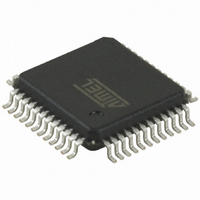AT32UC3B1128-AUT Atmel, AT32UC3B1128-AUT Datasheet - Page 596

AT32UC3B1128-AUT
Manufacturer Part Number
AT32UC3B1128-AUT
Description
IC MCU AVR32 128KB FLASH 48-TQFP
Manufacturer
Atmel
Series
AVR®32 UC3r
Specifications of AT32UC3B1128-AUT
Core Processor
AVR
Core Size
32-Bit
Speed
60MHz
Connectivity
I²C, IrDA, SPI, SSC, UART/USART, USB
Peripherals
Brown-out Detect/Reset, DMA, POR, PWM, WDT
Number Of I /o
28
Program Memory Size
128KB (128K x 8)
Program Memory Type
FLASH
Ram Size
32K x 8
Voltage - Supply (vcc/vdd)
1.65 V ~ 1.95 V
Data Converters
A/D 6x10b
Oscillator Type
Internal
Operating Temperature
-40°C ~ 85°C
Package / Case
48-TQFP, 48-VQFP
Package
48TQFP
Device Core
AVR32
Family Name
AT32
Maximum Speed
60 MHz
Operating Supply Voltage
1.8|3.3 V
Data Bus Width
32 Bit
Number Of Programmable I/os
28
Interface Type
I2S/SPI/TWI/USART/USB
On-chip Adc
6-chx10-bit
Number Of Timers
3
For Use With
ATSTK600-TQFP48 - STK600 SOCKET/ADAPTER 48-TQFPATAVRONEKIT - KIT AVR/AVR32 DEBUGGER/PROGRMMR770-1008 - ISP 4PORT ATMEL AVR32 MCU SPIATEVK1101 - KIT DEV/EVAL FOR AVR32 AT32UC3B
Lead Free Status / RoHS Status
Lead free / RoHS Compliant
Eeprom Size
-
Available stocks
Company
Part Number
Manufacturer
Quantity
Price
- Current page: 596 of 692
- Download datasheet (11Mb)
27.4.7
27.4.8
27.4.9
27.4.9.1
Figure 27-6. Scanning in JTAG Instruction
27.4.9.2
32059K–03/2011
TCK
TAP State
TMS
TDI
TDO
How to Initialize the Module
How to disable the module
Typical Sequence
Scanning in JTAG Instruction
Scanning in/out Data
TLR
To enable the TMS, TDI and TDO pins one clock pulse should be applied on TCK.
Independent of the initial state of the TAP Controller, the Test-Logic-Reset state can always be
entered by holding TMS high for 5 TCK clock periods. This sequence should always be applied
at the start of a JTAG session and after enabling the JTAG pins to bring the TAP Controller into
a defined state before applying JTAG commands. Applying a 0 on TMS for 1 TCK period brings
the TAP Controller to the Run-Test/Idle state, which is the starting point for JTAG operations.
To disable the TMS, TDI, and TDO pins the RESET_N pin must be pulled low.
Assuming Run-Test/Idle is the present state, a typical scenario for using the JTAG Interface
follows.
At the TMS input, apply the sequence 1, 1, 0, 0 at the rising edges of TCK to enter the Shift
Instruction Register (Shift-IR) state. While in this state, shift the 5 bits of the JTAG instructions
into the JTAG instruction register from the TDI input at the rising edge of TCK. During shifting,
the JTAG outputs status bits on TDO, refer to
input must be held low during input of the 4 LSBs in order to remain in the Shift-IR state. The
JTAG Instruction selects a particular Data Register as path between TDI and TDO and controls
the circuitry surrounding the selected Data Register.
Apply the TMS sequence 1, 1, 0 to re-enter the Run-Test/Idle state. The instruction is latched
onto the parallel output from the shift register path in the Update-IR state. The Exit-IR, Pause-IR,
and Exit2-IR states are only used for navigating the state machine.
At the TMS input, apply the sequence 1, 0, 0 at the rising edges of TCK to enter the Shift Data
Register (Shift-DR) state. While in this state, upload the selected Data Register (selected by the
present JTAG instruction in the JTAG Instruction Register) from the TDI input at the rising edge
of TCK. In order to remain in the Shift-DR state, the TMS input must be held low. While the Data
Register is shifted in from the TDI pin, the parallel inputs to the Data Register captured in the
Capture-DR state is shifted out on the TDO pin.
RTI SelDR SelIR CapIR ShIR
Instruction
Section 27.5
ImplDefined
for a description of these. The TMS
Ex1IR UpdIR RTI
AT32UC3B
596
Related parts for AT32UC3B1128-AUT
Image
Part Number
Description
Manufacturer
Datasheet
Request
R

Part Number:
Description:
DEV KIT FOR AVR/AVR32
Manufacturer:
Atmel
Datasheet:

Part Number:
Description:
INTERVAL AND WIPE/WASH WIPER CONTROL IC WITH DELAY
Manufacturer:
ATMEL Corporation
Datasheet:

Part Number:
Description:
Low-Voltage Voice-Switched IC for Hands-Free Operation
Manufacturer:
ATMEL Corporation
Datasheet:

Part Number:
Description:
MONOLITHIC INTEGRATED FEATUREPHONE CIRCUIT
Manufacturer:
ATMEL Corporation
Datasheet:

Part Number:
Description:
AM-FM Receiver IC U4255BM-M
Manufacturer:
ATMEL Corporation
Datasheet:

Part Number:
Description:
Monolithic Integrated Feature Phone Circuit
Manufacturer:
ATMEL Corporation
Datasheet:

Part Number:
Description:
Multistandard Video-IF and Quasi Parallel Sound Processing
Manufacturer:
ATMEL Corporation
Datasheet:

Part Number:
Description:
High-performance EE PLD
Manufacturer:
ATMEL Corporation
Datasheet:

Part Number:
Description:
8-bit Flash Microcontroller
Manufacturer:
ATMEL Corporation
Datasheet:

Part Number:
Description:
2-Wire Serial EEPROM
Manufacturer:
ATMEL Corporation
Datasheet:











